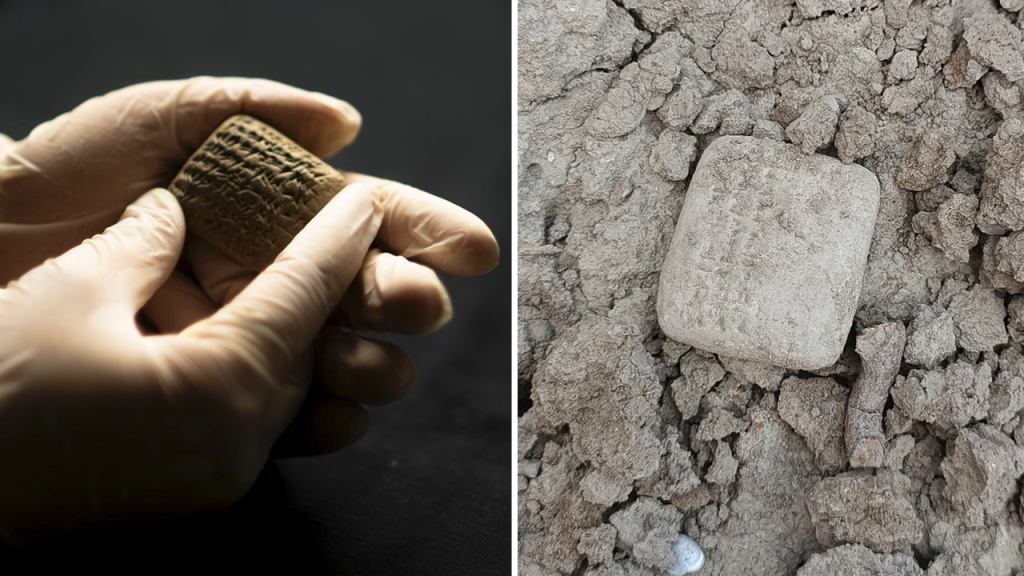Archaeologists working on earthquake restoration work made a significant discovery in Turkey – a 15th-century BC Akkadian cuneiform tablet at the Aççana Höyük site, known as Eski Alalah. The tablet is an administrative record or receipt detailing a large furniture shopping transaction. Cuneiform is a distinct way of writing that uses characters impressed on clay, rather than letters. The relic measures 4.2 to 3.5 centimeters with a thickness of 1.6 centimeters and displays a record of the purchase of tables, chairs, and stools made of wood. Turkey’s Minister of Culture and Tourism, Mehmet Nuri Ersoy, believes that the tablet will provide insights into the economic structure and state system of the Late Bronze Age, with linguists working to decipher all the details of the transaction.
The cuneiform tablet discovery sheds light on the ancient economy and state system of the Late Bronze Age. The tablet’s contents include details of the purchase of a significant amount of furniture, such as tables, chairs, and stools. This archaeological find provides valuable information about the trading practices, economic activities, and domestic life of that time period. The recovery of the relic has sparked further investigations by linguists to uncover more information about the transaction, including the specific items purchased, the buyer’s identity, and other relevant details. The tablet’s inscription on clay offers a unique opportunity to understand the administrative and economic practices of the Akkadian civilization.
The unique structure of cuneiform writing distinguishes it from the alphabet, utilizing characters impressed on clay to form syllables and words. The 600 to 1,000 characters used in cuneiform writing allowed for the recording of various administrative, legal, and economic transactions during ancient times. The tablet found at Aççana Höyük showcases the practical use of cuneiform in documenting everyday activities such as furniture shopping. The discovery presents a rare glimpse into the material culture and economic activities of the Akkadian period, inviting scholars to delve deeper into the intricacies of ancient society through the analysis of such archaeological finds. The unique writing system employed in cuneiform provides a valuable tool for deciphering the linguistic and economic clues contained within the tablet.
The clay-inscribed tablet discovered in Turkey offers a tangible link to the past, providing insights into the economic transactions and administrative practices of the Late Bronze Age. The details of the furniture shopping record found on the tablet offer a snapshot of the daily activities and commercial interactions of the Akkadian civilization. The discovery of the relic at Aççana Höyük highlights the importance of ongoing archaeological research and restoration efforts in uncovering hidden treasures from the past. The tablet’s inscription in cuneiform serves as a testament to the sophisticated administrative systems and economic networks that existed in ancient civilizations. By studying and deciphering the contents of the tablet, researchers aim to gain a deeper understanding of the social, cultural, and economic dynamics of the Akkadian society.
The Akkadian cuneiform tablet found at Aççana Höyük in Turkey represents a significant archaeological discovery that sheds light on the material culture and economic activities of the Late Bronze Age. The inscription on the tablet details a furniture shopping transaction, providing valuable insights into the trade practices and domestic life of the Akkadian civilization. The relic’s dimensions and thickness hint at the meticulous craftsmanship and attention to detail that characterized the production of cuneiform tablets during ancient times. The tablet’s discovery offers a unique opportunity for researchers to gain a better understanding of the economic structure and state system of the Late Bronze Age through the analysis of its contents. The ongoing work of linguists in deciphering the tablet’s inscription promises to reveal more information about the ancient transaction and the individuals involved in the furniture purchase.


